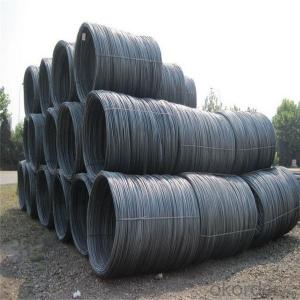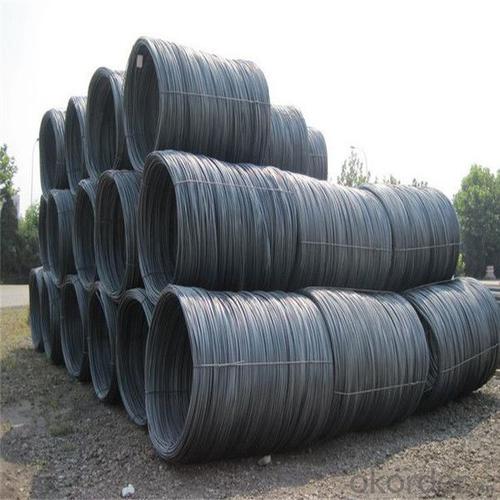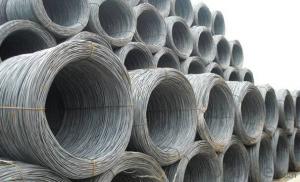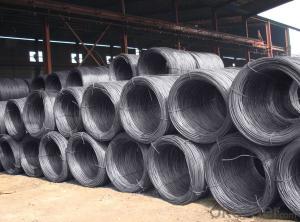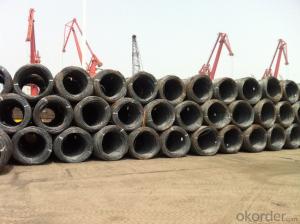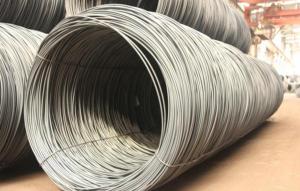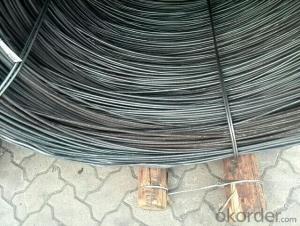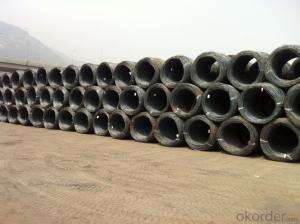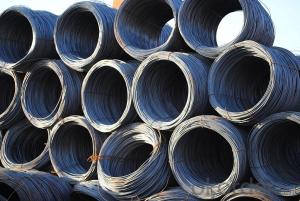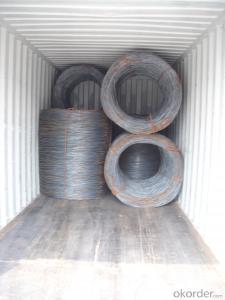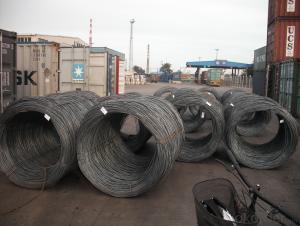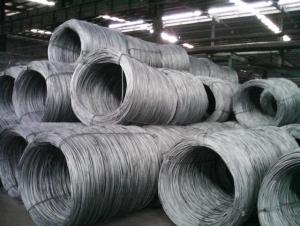Steel Wire Rod Sae 1008 from China steel mill
- Loading Port:
- Tianjin
- Payment Terms:
- TT OR LC
- Min Order Qty:
- 50 m.t.
- Supply Capability:
- 14672 m.t./month
OKorder Service Pledge
OKorder Financial Service
You Might Also Like
Specification
Steel wire is mainly used for prestressed and posttensioning technology in various
shapes of prestressed concrete structures,and widely used for civil engineering
construction, such as large scale railroad, highway bridges, building trusses,
overhead crane beams, industrial and prefabricated concrete floor, wall board,
tubular piles, PC water pipes, TV towers and nuclear power station, ETC. Active
strandards:GB/T5223, ASTMA421, BS5896, JISG3536, ISO6934, EN10138 or other special
required standards.
Our Advantage: High quality steel products from 1 class mills in
Reasonable price
Professionalism of the products
On-time delivery
Complete documents and certificates
Sincere service to meet our clients' requirements
Product Description :
Standard | AISI, ASTM, BS, DIN, GB, JIS |
Material/steel grade | Q195-Q235,SAE1006B,SAE1006CR, SAE1008B, SAE1008CR, SAE1010B, SAE1018B, or according to customers requirements |
Wire Gauge | 5.5-12mm |
Coil weight | 1.8-2.1mts |
MOQ | 25MT |
Delivery Time | 15-30 days after receipt of L/C or deposit by T/T |
Packing | In coil and load in container, if large quantity, by bulk vessel; Can be packed as customers' special requirements |
Payment terms | 1).100% irrevocable L/C at sight. 2).30% T/T prepaid and the balance against the copy of B/L. 3).30% T/T prepaid and the balance against L/C |
Application | widely used in machinery parts, manufacturing industry, electronics industry, metal tools and others |
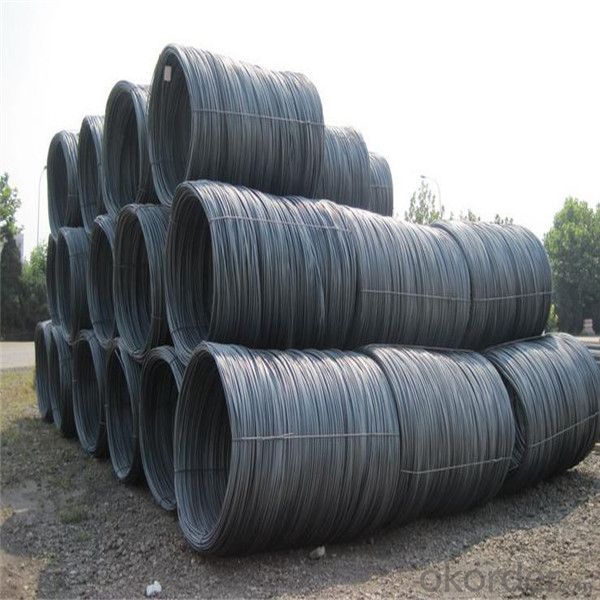

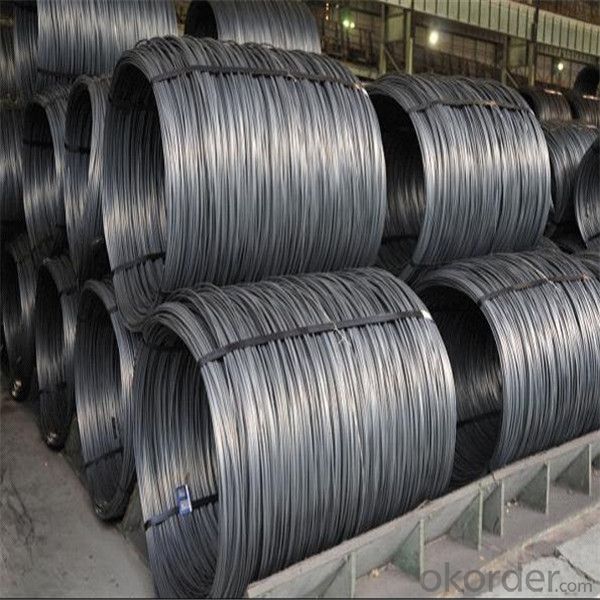
Application :
It generally used in braiding the hose for bathing product and machinery. With it
good flexibility, resistant to high temperature and resistant to corrosion, it
used widely in many industries.
Packing :
Hot-rolled wire rod is held in a unit with at least four steel straps in the
transverse direction and transported and stored without further packaging.
Before
the steel strapping is applied, the wire rod must be sufficiently compressed.
The strapping is fixed in the transverse direction with a single circumferential
strap so that the strapping does not slip and cause the coil to come apart.
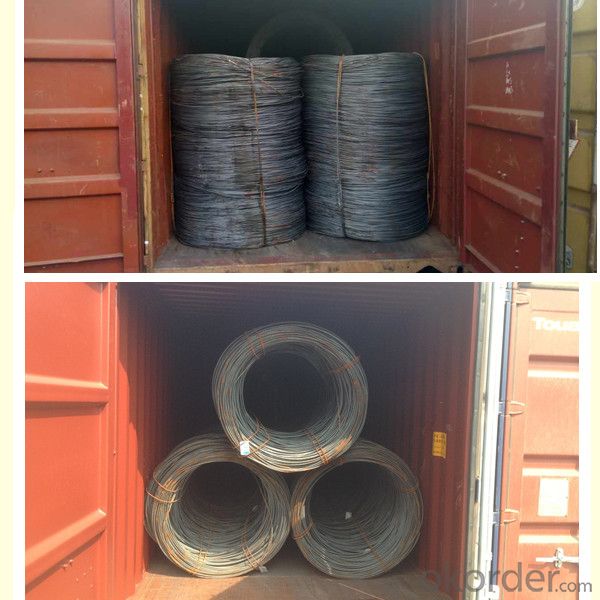

Our service:
(1) We cooperate with famous factories with advanced equipment and well trained workers.
(2) We can provide factory price with trading company service.
(3) We continuously work on the improvement of our processes, guaranteeing
consistently high standards of quality to keep none compensation.
(4) We guarantee 24 hours response and 48 hours solution providing service.
(5) We accept small order quantity before formal cooperation.
(6) We deliver the agreed quality at the agreed time, reacting to changes in
customer wishes in a flexible way.
(7) Due to our volume and selling power, we have excellent freight rates with
shipping lines.
(8) We strive to always be fair and honest in our dealings with customers.
(9) We strive to work together with customers to achieve much more than we can
achieve alone.
(10) Through our passion and commitment we aim to be a market leader in all our
key markets. To maintain our position as market leader we must continue to add
value in all that we do.
FAQ:
1.Q: What's your MOQ(minimum order quantity)?
A: One full container, mixed acceptable .
2. Q: What's your packing methods?
A: Packed in bundle or bulk ..
3. Q: How can I buy CNBM products in my country?
A:Please send us an inquiry or email ,we will reply to you if there is distributor in your country
4. Q: Can we visit your factory?
A: Warmly welcome. Once we have your schedule, we will arrange the
professional sales team to follow up your case.
5. Q: How long does it take to get the product if i place an order?
A:With the process of your requirements,we will pack and deliver in 3
-7 days. If it is by sea shipment,it will take 15-45 days depending on different locations
- Q: What are the major growth strategies adopted by companies in the steel wire rod industry?
- In the steel wire rod industry, companies adopt various growth strategies to expand their market share and increase their profitability. Some of the major growth strategies adopted by companies in this industry include: 1. Market Expansion: Companies focus on expanding their market reach by targeting new geographic regions or entering new market segments. This strategy involves investing in market research and developing new distribution channels to reach a wider customer base. 2. Product Innovation: Steel wire rod companies constantly invest in research and development to develop new and improved products. They strive to stay ahead of the competition by offering innovative solutions that cater to the evolving needs and preferences of customers. This strategy helps companies capture new customers and retain existing ones. 3. Vertical Integration: Some companies in the steel wire rod industry adopt a vertical integration strategy by acquiring or investing in companies involved in the upstream or downstream processes of the industry. By integrating backward or forward in the value chain, companies can gain more control over their supply chain, reduce costs, and enhance their competitiveness. 4. Strategic Partnerships and Alliances: Collaborating with other industry players through strategic partnerships and alliances can be an effective growth strategy. Companies can benefit from shared resources, knowledge exchange, and joint marketing efforts, which can lead to increased market penetration and customer acquisition. 5. Mergers and Acquisitions: Mergers and acquisitions are common in the steel wire rod industry as companies seek to consolidate their market position and achieve economies of scale. By acquiring or merging with other companies, they can eliminate competition, access new markets, and diversify their product offerings. 6. Diversification: Steel wire rod companies may also adopt a diversification strategy by expanding into related industries or product lines. This strategy allows companies to reduce their dependence on a single market and mitigate risks associated with market fluctuations. For example, a company may diversify into manufacturing wire mesh or wire products for different industries. 7. Operational Efficiency: Improving operational efficiency is a crucial growth strategy for companies in the steel wire rod industry. By investing in advanced technologies, automation, and lean manufacturing practices, companies can reduce costs, increase productivity, and improve overall profitability. It is important to note that the specific growth strategies adopted by companies in the steel wire rod industry may vary depending on their size, resources, and market dynamics. However, these strategies provide a general overview of the major approaches employed by companies to achieve growth and success in this highly competitive industry.
- Q: How is steel wire rod used in the oil and gas industry?
- Steel wire rod is used in the oil and gas industry for various applications such as reinforcing and strengthening drilling equipment, manufacturing pipelines, and constructing oil rigs. It provides high tensile strength, durability, and resistance to corrosion, making it suitable for critical operations in this industry.
- Q: What are the different fatigue testing methods for steel wire rod?
- To evaluate the fatigue strength and performance of steel wire rods, there are several methods available. The first method is the Rotating Bending Fatigue Test. This test applies a rotating bending load to the steel wire rod, simulating real-world cyclic loading conditions. The rod is subjected to a constant load while being rotated at a specified speed. The number of cycles until failure is recorded to determine the fatigue strength of the wire rod. Next is the Axial Fatigue Test, where the steel wire rod is cyclically loaded in an axial manner. This test is commonly conducted using hydraulic or servo-hydraulic testing machines. The number of cycles until failure is recorded. This method is useful for evaluating the fatigue performance of steel wire rods used in tension applications, like suspension cables. Another method is the Torsional Fatigue Test. Here, the steel wire rod is subjected to a cyclic torsional load, simulating twisting forces experienced in certain applications. A constant torque is applied while the rod is rotated at a specified speed. The number of cycles until failure is recorded to assess the fatigue strength of the wire rod under torsional loading conditions. Lastly, the Combined Loading Fatigue Test involves subjecting the steel wire rod to a combination of different loading types, such as axial, bending, and torsional loads. This simulates the complex loading conditions encountered in real-world applications. Cyclic loading is applied in multiple directions simultaneously or sequentially. The number of cycles until failure is recorded to evaluate the fatigue performance of the wire rod under combined loading conditions. It is crucial to choose the appropriate fatigue testing method based on the specific application and loading conditions the rod will experience. The selected method should closely replicate the actual loading conditions to obtain accurate and reliable fatigue strength data for the wire rod.
- Q: What are the different types of wire drawing dies used for steel wire rod?
- There are several types of wire drawing dies that are commonly used for steel wire rod. These include: 1. Single crystal natural diamond dies: These dies are made from a single crystal diamond and are known for their high hardness and wear resistance. They can be used for drawing high carbon steel wire rod as well as stainless steel wire rod. 2. Polycrystalline diamond (PCD) dies: PCD dies are made from multiple small diamond crystals that are bonded together. They offer good wear resistance and can be used for drawing steel wire rod with intermediate carbon content. 3. Tungsten carbide dies: Tungsten carbide is a hard and durable material that is often used for wire drawing dies. These dies can handle high carbon steel wire rod and are known for their ability to withstand high pressures and temperatures. 4. Natural diamond dies with carbide support: These dies have a natural diamond core with a carbide support structure. The diamond provides excellent wear resistance while the carbide support adds strength and stability. They are suitable for drawing steel wire rod with high carbon content. 5. PCD dies with carbide support: Similar to the above, these dies have a PCD core with a carbide support structure. They offer good wear resistance and can handle steel wire rod with intermediate carbon content. 6. Polycrystalline diamond composite (PDC) dies: PDC dies are made by sintering diamond particles with a binder material. They are known for their high wear resistance and are often used for drawing steel wire rod with low to medium carbon content. Each type of wire drawing die has its own advantages and is suitable for specific applications based on the carbon content and other properties of the steel wire rod being drawn.
- Q: How is steel wire rod used in the production of wire shelves?
- Steel wire rod is used in the production of wire shelves as it serves as the primary raw material for manufacturing the wire mesh grids that form the shelves' structure. The steel wire rod is processed and shaped into the desired dimensions and then welded or woven together to create the sturdy and durable wire shelves.
- Q: How is the steel wire rod market affected by mergers and acquisitions?
- Mergers and acquisitions have a significant impact on the steel wire rod market. When companies in this industry merge or acquire each other, it results in consolidation within the market. This consolidation can have both positive and negative effects on the overall dynamics of the market. One of the main consequences of mergers and acquisitions in the steel wire rod market is a potential decrease in competition. When two or more companies merge, they combine their resources, production capabilities, and market share. This creates a larger and more dominant player in the industry, which can lead to reduced competition. As a result, the merged entity gains more control over pricing and market conditions. On the positive side, mergers and acquisitions can also generate economies of scale. By merging operations and streamlining processes, companies can achieve cost savings and improve efficiency. This, in turn, can lower production costs, potentially leading to lower prices for customers. Additionally, the merged entity may gain access to a wider customer base and distribution network, allowing them to reach new markets and increase their market share. However, there are also potential downsides to mergers and acquisitions in the steel wire rod market. Consolidation may result in job losses as duplicate positions are eliminated to achieve cost synergies. Moreover, if the merged entity becomes too dominant in the market, it may have the power to dictate terms to other market participants, potentially limiting choices and options for customers. Overall, the impact of mergers and acquisitions on the steel wire rod market depends on various factors, such as the size and scope of the merger, the market structure, and the competitive landscape. While consolidation can bring about positive and negative effects, it is crucial for regulators to monitor and ensure fair competition to protect consumer interests and maintain a healthy market environment.
- Q: How is steel wire rod used in the production of wire mesh for automotive applications?
- Steel wire rod is a crucial component in the production of wire mesh for automotive applications. It serves as the raw material that is drawn into thinner wires, which are then woven or welded together to create the wire mesh. This mesh is used in various automotive applications such as reinforcing car seats, creating protective barriers, and forming sturdy grilles. The strength and durability of steel wire rod make it an ideal choice for manufacturing wire mesh, ensuring the safety and reliability of automotive components.
- Q: How is steel wire rod used in the production of wire mesh for concrete reinforcement?
- Steel wire rod is used in the production of wire mesh for concrete reinforcement by being drawn through a series of dies to reduce its diameter and increase its length. This process, known as wire drawing, creates a strong and uniform wire that is then woven or welded into mesh sheets. The wire mesh is then placed within the concrete mixture to provide additional strength, prevent cracking, and enhance the overall structural integrity of the concrete.
- Q: How are steel wire rods used in the manufacturing of fasteners?
- Steel wire rods are used in the manufacturing of fasteners as they provide the necessary strength and durability required for these components. The wire rods are first drawn into the desired diameter, and then cut into appropriate lengths. These lengths are further processed to form different types of fasteners like screws, bolts, nuts, and rivets. The steel wire rods serve as the raw material for fastener production, ensuring that the resulting products can withstand heavy loads and resist corrosion, thus ensuring the reliability and longevity of the fasteners.
- Q: What are the common applications of cold heading quality steel wire rod?
- CHQ steel wire rod, known for its unique properties, is widely utilized in various industries. Its applications include: 1. Fasteners: CHQ steel wire rod is commonly employed in producing fasteners like screws, bolts, nuts, and rivets. Its high strength and remarkable ductility enable these fasteners to endure heavy loads and maintain their integrity even in extreme conditions. 2. Automotive Parts: The automotive industry extensively relies on CHQ steel wire rod for manufacturing critical components such as bolts, screws, and pins. These components necessitate outstanding strength and fatigue resistance to ensure vehicle safety and reliability. 3. Electrical Connectors: The excellent electrical conductivity properties of CHQ steel wire rod make it invaluable for producing electrical connectors and terminals. The cold heading process guarantees reliable connections and minimizes the risk of corrosion due to the high-quality surface finish achieved. 4. Construction and Machinery: CHQ steel wire rod finds extensive use in the construction and machinery sectors. It is utilized in creating essential structural components like bolts, pins, and anchor rods, which are vital for building and maintaining infrastructure. 5. Consumer Goods: CHQ steel wire rod plays a crucial role in manufacturing a wide range of consumer goods, including appliances, furniture, and sporting equipment. It provides the necessary strength and durability to withstand daily use and ensure long-lasting performance. In summary, CHQ steel wire rod is highly versatile and applicable in numerous industries. Its exceptional strength, ductility, and surface finish make it the ideal choice for industries requiring reliable and durable components.
Send your message to us
Steel Wire Rod Sae 1008 from China steel mill
- Loading Port:
- Tianjin
- Payment Terms:
- TT OR LC
- Min Order Qty:
- 50 m.t.
- Supply Capability:
- 14672 m.t./month
OKorder Service Pledge
OKorder Financial Service
Similar products
Hot products
Hot Searches
Related keywords
